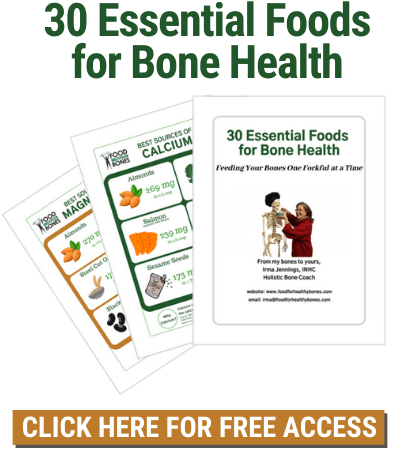When Skelly (the skeleton and bones that lives in us all) wants a special treat I pull out my recipe for kale chips. You see, kale is a superfood when it comes to building strong bones. Here’s why.
- Kale is an alkalizing food.
Eating too much protein and too many grains makes your body produce more acid. When your blood becomes too acidic, your body sucks alkalizing minerals like calcium out of your bones to rebalance everything. But that leaves you with weaker bones. Kale can help counter that calcium leaching. When you digest kale, your body produces alkaline byproducts to lower acid levels naturally.
- Vitamin K.
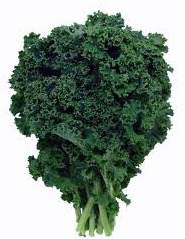 Green leafy vegetables from the cabbage family – like kale – are rich in vitamin K1. That’s the vitamin that helps your blood clot. But in your gut, bacteria convert vitamin K1 to vitamin K2. And that’s critical for healthy bones.
Green leafy vegetables from the cabbage family – like kale – are rich in vitamin K1. That’s the vitamin that helps your blood clot. But in your gut, bacteria convert vitamin K1 to vitamin K2. And that’s critical for healthy bones.
You see, vitamin K2 puts calcium where it belongs – in your bones. Without K2, bones become porous and calcium collects in the arteries or organs and hardens there. In addition, K2 works with vitamin D3 to help produce cells that build bones (osteoblasts). K2 plus D3 also inhibits production of cells that break down bone (osteoclasts).
- Vitamin A.
Kale and other dark leafy greens are rich in beta-carotene. Your body converts beta-carotene to vitamin A. That’s important because your bones need vitamin A for their remodeling process.
But excess vitamin A from supplements or animal foods like liver, eggs, and butterfat has been linked to bone loss and an increase in the risk of hip fracture. Researchers think too much vitamin A could trigger an increase in bone-busting osteoclasts. It may also interfere with vitamin D which you need for building bone.
But getting vitamin A from kale is safe. Beta-carotene hasn’t been linked to any adverse bone effects.
- Vitamin C
Osteoporosis has been called “scurvy of the bones.” You see, your body needs vitamin C to maintain a healthy balance of bone-building osteoblasts and bone-destroying osteoclasts. When your levels of vitamin C are low, you have trouble building new bone and your bone breakdown speeds up.
Vitamin C also helps build the collagen matrix of your bones – the part that keeps them flexible, so they bend instead of break.
- Calcium.
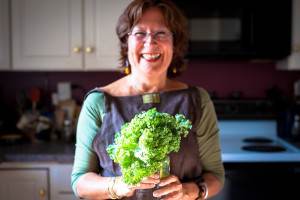
You’ve heard me say before that I like to get my calcium from leafy greens. But some greens are better than others when it comes to calcium absorption. Spinach and Swiss chard contain oxalates which bind to their calcium and prevent your body from absorbing it. Kale, on the other hand, has low levels of oxalates so your body can absorb all that good calcium.
- Magnesium.
Without enough magnesium, bone nutrients like calcium and vitamin D can’t do their jobs. Your body needs magnesium to convert vitamin D into its active form. If it’s not activated it can’t turn on your body’s calcium absorption.[i]
You also need magnesium to stimulate the hormone calcitonin. That helps draw calcium out of the blood and soft tissues and put it back into the bones. Too much calcium floating around in your blood and tissues can increase your risk of arthritis, heart attack, and kidney stones, as well as osteoporosis.[ii]
Kale’s best bone nutrients:
|
One Cup of Cooked Kale |
||
| Nutrient | Amount | Daily Value |
| Vitamin A | 17709 IU | 354% |
| Vitamin C | 53.3 mg | 89% |
| Vitamin K | 1062 mcg | 1328% |
| Calcium | 93.6mg | 9% |
| Magnesium | 23.4mg | 6% |
Here’s the recipe for Skelly’s favorite bone-healthy snack.
Best Kale Chips Recipe
Printable Version Click HERE
Ingredients:
- 1 Bunch of dinosaur (lacinato) or curly kale
- 1 or 2 Tb of extra virgin olive oil
- Sea salt to taste.
- You can also add any additional spices you like such as onion or garlic powder, turmeric, etc.
Or for my more experimental readers, create this lovely spice blend from Practical Paleo. Keep leftover in your cabinet and label with the "date made"
- INDIAN SPICE BLEND:
- Yield - 4 1/2 tablespoons
- 2 tablespoons onion powder
- 2 teaspoons garam masala
- 2 teaspoons coriander
- 1 teaspoon sea salt
- 1 teaspoon black pepper
- 1/2 teaspoon cinnamon
- 1/2 teaspoon red pepper flakes
Preparation:
- Pre‐heat oven to 350º F.
- Cut stems off the kale and remove center stalk.
- Wash the kale and dry thoroughly (otherwise your chips will be soggy). TIP: I usually wash the kale before making the kale chips, wrap them tightly in paper towel and put the paper towel in a plastic bag then place in the fridge overnight.
- Cut or tear the kale into 2 inch strips with a knife or kitchen scissors. Toss the kale with olive oil, sea salt and any spices.
- Spread kale out in a glass baking dish or a stainless steel cooking sheet (non-aluminum) and bake for 5‐
- Turn chips over and bake for another 5‐7 minutes. Caution: This is no time for multi-tasking. You need to keep an eye on these treats so they don’t burn.
It’s best to consume kale chips immediately while they’re crisp. But if you have leftovers keep them fresh in a glass jar.
My question for you.
When it comes to choosing the right foods to optimize your bone health, what is the single biggest challenge, frustration or problem you’ve been struggling with?
Please let me know so I can write content that meets your needs.
Plus I have wonderful alkaline salad dressing waiting for you on the other side to thank you for your time 🙂.
Click here to share your challenges ----> HERE
From my delicious bones to yours,
Irma
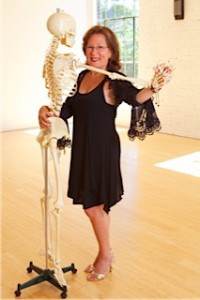
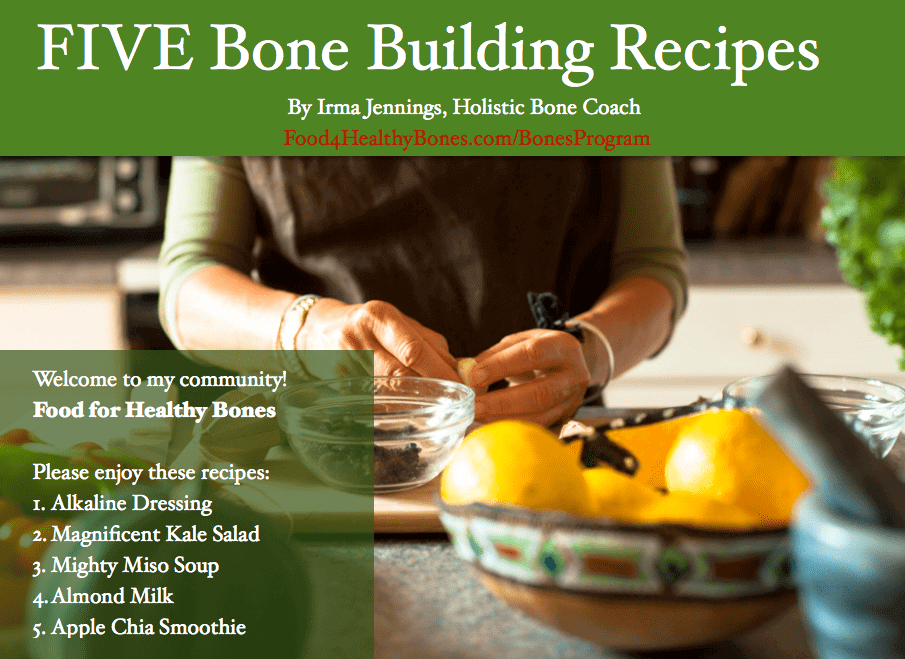
[ii] Zofková I, , Kancheva RL. The relationship between magnesium and calciotropic hormones. Magnes Res. 1995 Mar; 8 (1): 77-84. Pubmed 7669510
Let Me Support Your Bones
Get Customized In-Depth Private Session
Book a Private Coaching with Irma Now
Join Our Amazing Bone Tribe Community
Get the support & information you need to live fearlessly with your bones diagnosis
From my bones to yours,
Irma Jennings, INHC
Your Holistic Bone Coach
[email protected]
